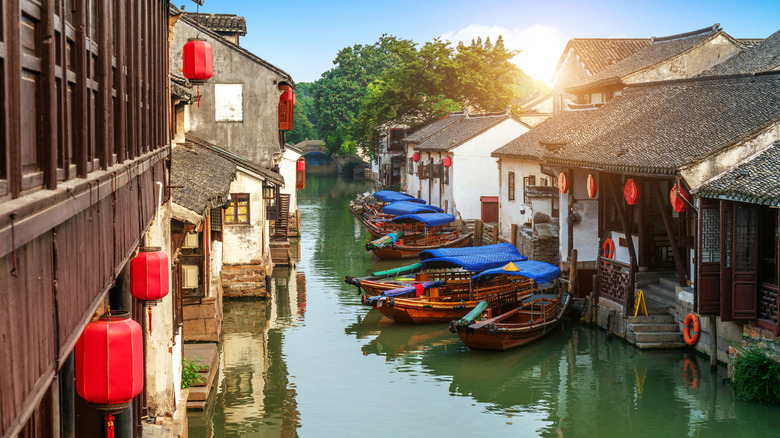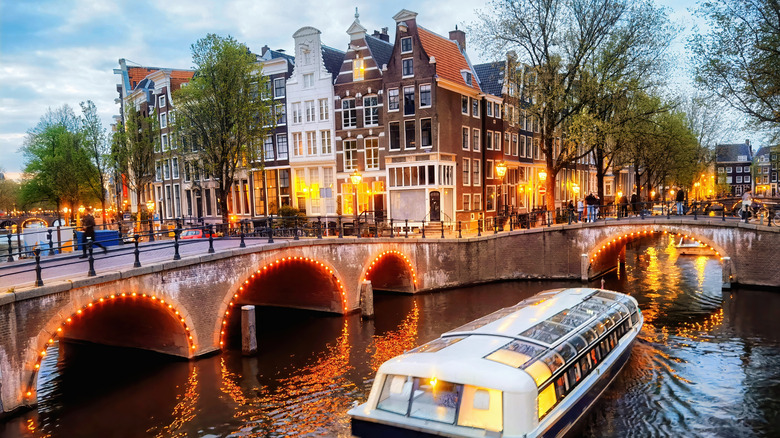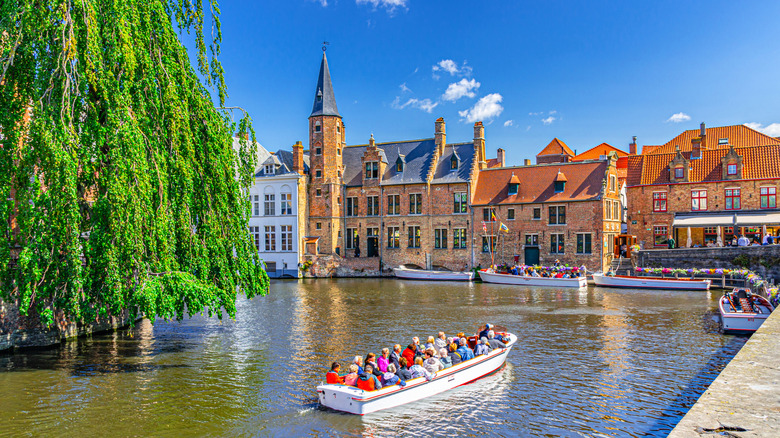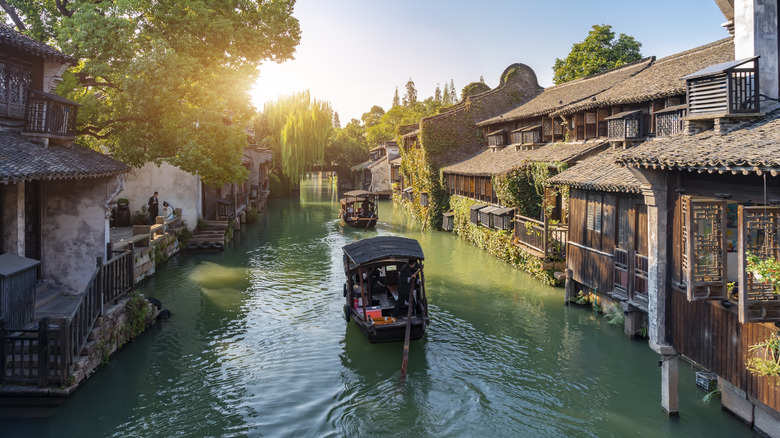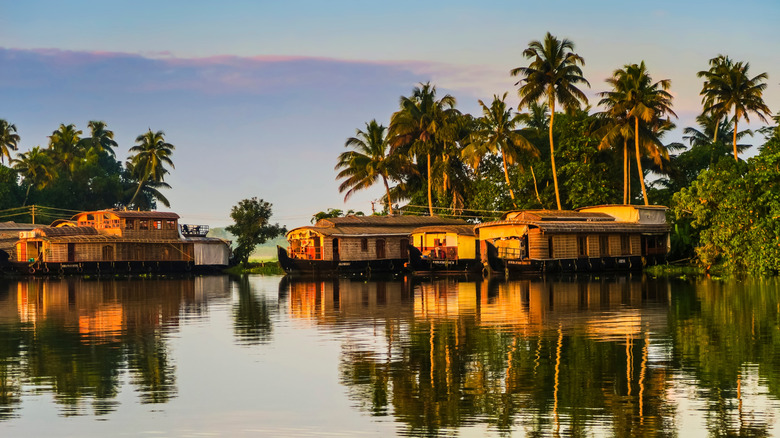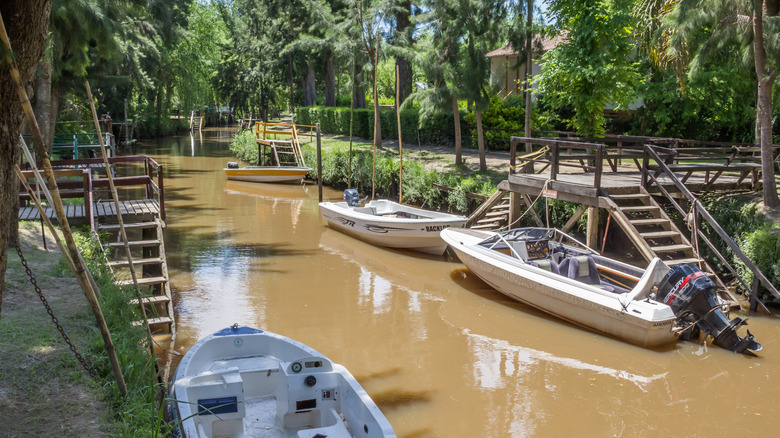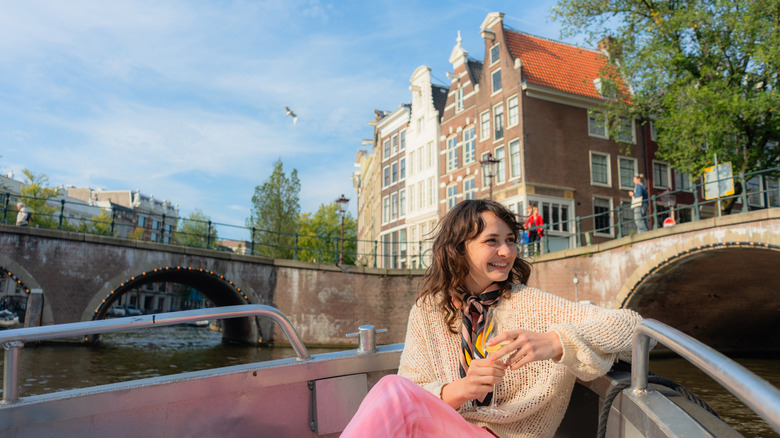The Best Historic Canal Cities To Wander (Other Than Venice), According To Research
With its labyrinth of canals, puttering vaporettos, and grand palazzos, Venice is undoubtedly the world's most enigmatic canal city. Not only is it steeped in history, but every aspect of Venice — from its art to architecture and culture — seems tinged in beauty. Yet for all it has going for it, Venice grapples with its own set of challenges. As one of the most overtouristed places in Europe, the city deals with boisterous tourists, overburdened infrastructure, and locals being edged out of an expensive, tourist-catered environment.
If you're adamant on a holiday involving bridges, boats, and waterways but aren't a fan of elbowing your way through throngs of tourists, here's the good news: there are a handful of equally historic and intriguing canal cities around the world to wander. Think Suzhou, Bruges, and Alappuzha. Historically, canals were used for purposes of irrigation, trade transportation, and defense systems. Today, canal cities continue to captivate travelers for the novelty of intricate waterways intertwined with modern life, shaping each city's culture, atmosphere, and character. With the help of travel guides, blogs, and traveler testimonials, we curated a list of five historic cities spanning Europe, Asia, and South America, each steeped in its own history, culture, and charm.
Amsterdam, the Netherlands
One can't talk about canal cities without mentioning Amsterdam. Dominated by an intricate network of 165 canals and 1,281 bridges, progressively built since the beginning of the 17th century, the canal ring garnered a deserving distinction as a UNESCO World Heritage Site. Shaped by visionary feats of hydraulic and civil engineering for the purpose of trade, shipping, and flood control, Amsterdam has retained its historical charm while adapting to modern life.
Visitors explore Amsterdam's waterways via the numerous boat tours offered by different companies, which now operate emission-free vessels following the city's ban on gas and diesel boat engines, a major change offering a quieter and more sustainable way for tourists to see the city. Lined with quaint centuries-old buildings, it's amazing to realize that locals live not just over the water but also on it: about 750 houseboats are moored along the canals, occupied by residents of the city just as traders had done in the 17th century. Out of the water, Amsterdam is easily explored on foot or, for the more daring, by bike. As the most ubiquitous way of getting around, biking in Amsterdam is not for the faint-hearted, as locals pedal along extensive bike paths with relentless speed and purpose. Adopt the unwritten rules ingrained in every Amsterdam local: keep to your lane, avoid swerving, and signal before every turn.
Even more than its museums, restaurants, boutiques, and parks, what is most poignant about Amsterdam is how its canals bear witness to centuries of life unfolding along its banks. As a Redditor aptly put it, "Amsterdam is special because people live in the old town despite tourists, not because of them."
Bruges, Belgium
With its beautifully preserved Medieval and Gothic architecture, cobblestone streets, and picturesque canals, Bruges boasts a cultural and architectural atmosphere that rivals Venice (but with noticeably fewer crowds) — easily earning its historic center a UNESCO World Heritage Site spot. Its canals have been present since the 9th century, developing into a more robust and structured network to accommodate burgeoning trade during the 12th century.
Often welcoming day-trippers making an hour-long trip from Brussels, Bruges is compact enough to explore on foot but packs a punch for sightseeing. Taking a tour of its famed canals is an efficient, informative, and enjoyable way to orient yourself to the city from a different perspective. Canal tours kick off from only five docking points around Bruges. Routes are pretty much standard, though there may be deviations following weather or construction work around the waterways. The boats will float by sites including the Beguinage, a 13th-century enclosed compound (and a UNESCO World Heritage Site) formerly populated by single or widowed women (beguines) who endeavored to serve God spiritually while remaining part of secular society, and the 12th-century Saint John's Hospital, which catered to pilgrims and the underprivileged, among others. You'll also catch a glimpse of Bruges' Belfry, which towers 272 feet over the rooftops of the medieval buildings surrounding it.
Disembarking from the boat, take in a walking tour for a deeper dive into the city's fascinating history. Walking unveils Instagram-worthy views of Bruges' waterways against a backdrop of medieval buildings, flower-lined streets, and scenic bridges. Find your way to Peerdebrug bridge (Horse Bridge) to view the Groenerei (Green Canal) — it's considered the most romantic canal in all of Bruges.
Suzhou, China
Just an hour-and-a-half drive from futuristic, skyscraper-laden Shanghai (which earned the moniker "a Jetsons world" from travel guru Rick Steves) lies the Venice of the East: Suzhou, a charming water town nestled in eastern China's Yangtze River Delta region with a history spanning more than 2,500 years. Though situated a world away from its European counterpart, Suzhou's compelling similarities to Venice won the admiration of explorer Marco Polo, who visited the small water town in the 13th century — high praise indeed from a Venetian himself.
Like Venice, Suzhou is dominated by waterways, with daily life bustling along its banks. Unlike Venice, Suzhou's urban fabric is dotted with red traditional Chinese lanterns, freshly washed clothes hanging from makeshift clotheslines along its serpentine alleyways, and groups of elderly Chinese people playing cards along the sidewalks. Traditional wooden boats, filled with tourists or merchants, float along the tranquil green canal waters, disappearing briefly beneath the quaint arches as locals and tourists lean over the railings above, jostling for space to snap a photo. The streets are lined with restaurants, traditional tea houses, cafés, and establishments selling everything from souvenir trinkets to signature red bean dumpling snacks. With over 4,000 years of silk cultivation, Suzhou is the place to purchase silk in all forms.
Unless you speak Mandarin, most foreign travelers opt for customized boat tours with English-speaking guides. After a canal ride, get your step count in by exploring Suzhou's streets (the historic pedestrian street of Pingjiang Road is packed with restaurants and souvenir shops) and the city's famous Lingering Garden, a revelation of Classical Chinese-style landscape architecture and one of China's four most-visited gardens.
Alappuzha, India
Far removed from the noise and chaos often associated with Indian cities, the canals of Alappuzha (also referred to by its British colonial-era name, Alleppey) tell a different story. Located in Kerala on India's southwestern coast, these backwaters — dubbed India's Venice of the East for its famous scenic waterways, lagoons, lakes, and canals — welcomed a bustling spice trade back in the 18th century.
Today, tourists can drift along the palm tree-lined waterways through houseboat cruises. Formerly used to transport rice and other goods across the backwaters, the houseboats (kettuvallams), spanning around 80 feet long, are constructed entirely by lashing wood and bamboo together with coir rope. They took a backseat as transportation infrastructure around Kerala improved, but were later popularized again to cater to tourism. The formerly utilitarian boats are now fitted with overnight cruise essentials: bedrooms, bathrooms, kitchens, and living areas, ranging from luxurious interiors to more modest lodgings. Regardless, they offer glimpses of life along the Kerala backwaters, with stops at small towns and markets. Looking for more adventure and flexibility? Paddling along the backwaters on a kayak will enable you to visit the narrower canals that houseboats can't access.
On terra firma, several landmarks bear the cultural heritage and maritime history of Alappuzha. Explore the city's 150-year-old lighthouse or visit the International Coir Museum, dedicated to the handcrafted coconut palm fiber material that is intertwined — literally and figuratively — into everyday Kerala life, from handicrafts to ornaments.
Tigre, Argentina
Nestled in the Paraná Delta, just 30 minutes away from Buenos Aires, is Tigre, a town whose location — surrounded by the Luján, Reconquista, and Tigre rivers — transformed the natural river delta into Argentina's version of Venice with sprawling waterways and islands reachable only by boat. Agricultural produce made its way from the delta's islands to Tigre, on its way to Buenos Aires, between the 16th and 18th centuries. But Tigre blossomed beyond a mere port town with the arrival of Tigre Club, Argentina's first casino, in the early 20th century. The casino, along with the infrastructure for water sports like sailing and rowing, established Tigre as an accessible leisure destination close to the city. Though its popularity waned in the 1930s, its waterfront charm continually appealed to tourists, most of whom explored the delta's canals on canoe or kayak.
There are plenty of boat tours of the Tigre River Delta, ranging from group excursions to private catamaran tours. For the most budget-friendly option, board a lancha colectiva (Interisleña water bus), which locals use to commute to and from Tigre and the delta's islands, provided you can navigate the language barrier. For a real taste of delta life, consider renting a stilted house on the islands for a relaxing retreat amid Tigre's charming, canal-laced landscape.
Methodology
We cast a wide net to capture a geographically diverse range of canal cities, showing how culture, architecture, and history have shaped each destination. Our jumping-off point was lists of canal cities by travel guides like Fodor's Travel, Qantas Airlines' inflight magazine Travel Insider, and the Daily Mail. We also pored over numerous travel bloggers' lists, handpicking both well-known and off-the-beaten-path destinations for variety before delving into in-depth, site-specific features from sources like Lonely Planet, Rough Guides, TimeOut, and Condé Nast Traveler, as well as official tourism websites and tour operators. Travel videos, Reddit threads, and TripAdvisor reviews provided first-hand perspectives on these beautiful and intriguing canal-crossed landscapes around the world.
